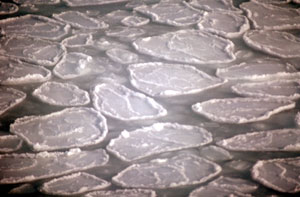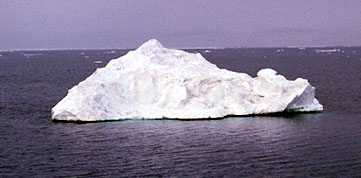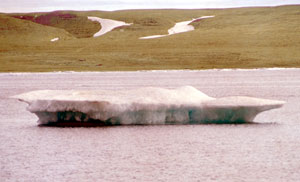

|
|
|
|
|
|
|---|
| Francais | Contact Us | Help | Search | Canada Site |
|---|---|---|---|---|
| What's New | Topics | Publications | Weather | EC Home |
| About Us | ||||
| CIS Home | Ice Conditions | Ice Codes | Ice Archive | Education Corner |
| Ice Services | Resources |
Pancake Ice
Predominantly circular pieces of ice 30 cm to 3 m in diameter, up to 10 cm in thickness, with raised rims due to the pieces striking against one another. It may form on a slight swell from grease ice, shuga or slush or as a result of the breaking of ice rind, nilas or, under severe conditions of swell or waves, of grey ice. It also sometimes forms at some depth at an interface between water bodies of different physical characteristics where it floats to the surface. It may rapidly form over wide areas of water.

Ice Cake
Any relatively flat piece of ice less than 20 m across.

Floe
Any relatively flat piece of ice 20 m or more across. Floes are subdivided according to horizontal extent as follows:

Floeberg
A massive piece of ice composed of a hummock or a group of hummocks, frozen together and separated from any ice surroundings. They may typically protrude up to 5 m above water-level.

Brash Ice
Accumulation of floating ice made up of fragments not more than 2 m across, the wreckage of other forms of ice.

Fast Ice
Ice which forms and remains fast along the coast. It may be attached to the shore, to an ice wall, to an ice front, between shoals or grounded icebergs. Vertical fluctuations may be observed during changes of sea-level. It may be formed "in-situ" from water or by freezing of floating ice of any age to shore and can extend a few metres or several hundred kilometres from the coast. It may be more than one year old in which case it may be prefixed with the appropriate age category (old, second-year or multi-year). If higher than 2 m above sea-level, it is called an ice shelf.

Anchor Ice
Submerged ice attached or anchored to the bottom, irrespective of the nature of its formation.
Grounded Ice
Floating ice which is aground in shoal water.

